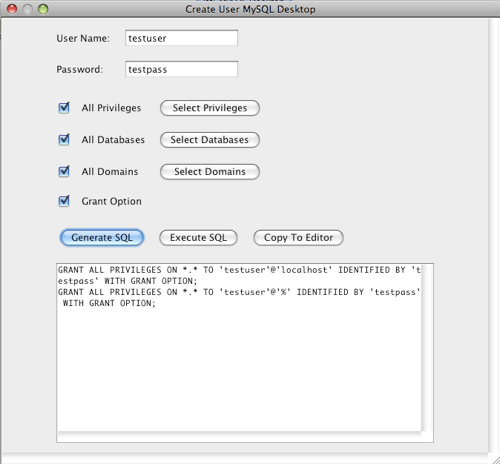
įor people not familiar with MySQL syntax, here are handy shell functions which are easy to remember and use (to use them, you need to load the shell functions included further down). If you've got Access denied with above, specify -u (for user) and -p (for password) parameters, or for long-term access set your credentials in ~/.my.cnf, e.g. Or print statement from the standard input: $ echo "FOO STATEMENT" | mysql To run from shell, use -e parameter (replace SELECT 1 with one of above commands): $ mysql -e "SELECT 1" To run above commands, you need to run mysql command and type them into prompt, then logout by quit command or Ctrl- D. Then to reload newly assigned permissions run: FLUSH PRIVILEGES GRANT ALL ON my_db.* TO ALL ( priv_type) can be replaced with specific privilege such as SELECT, INSERT, UPDATE, ALTER, etc. Then to grant all access to the database (e.g. To create user in MySQL/MariaDB 5.7.6 and higher, use CREATE USER syntax: CREATE USER IDENTIFIED BY 'new_password'
Mysql create user network mask password#
IDENTIFIED BY 'password' - As you would have guessed, this sets the password for that user. If you only want it from the same machine, use localhost 'hostname' tells MySQL what hosts the user can connect from.

Note: You must have the single quotes in there. TO - 'user' is the username of the user account you are creating. You can replace the * with specific table names or store routines if you wish. This does not include the privilege to use the GRANT command however.ĭbtest.* - This instructions MySQL to apply these rights for use in the entire dbtest database. GRANT - This is the command used to create users and grant rights to databases, tables, etc.ĪLL PRIVILEGES - This tells it the user will have all standard privileges. If you are running the code/site accessing MySQL on the same machine, hostname would be localhost.

Try this to create the user: CREATE USER this to give it access to the database dbTest: GRANT ALL PRIVILEGES ON dbTest.* To IDENTIFIED BY 'password'


 0 kommentar(er)
0 kommentar(er)
